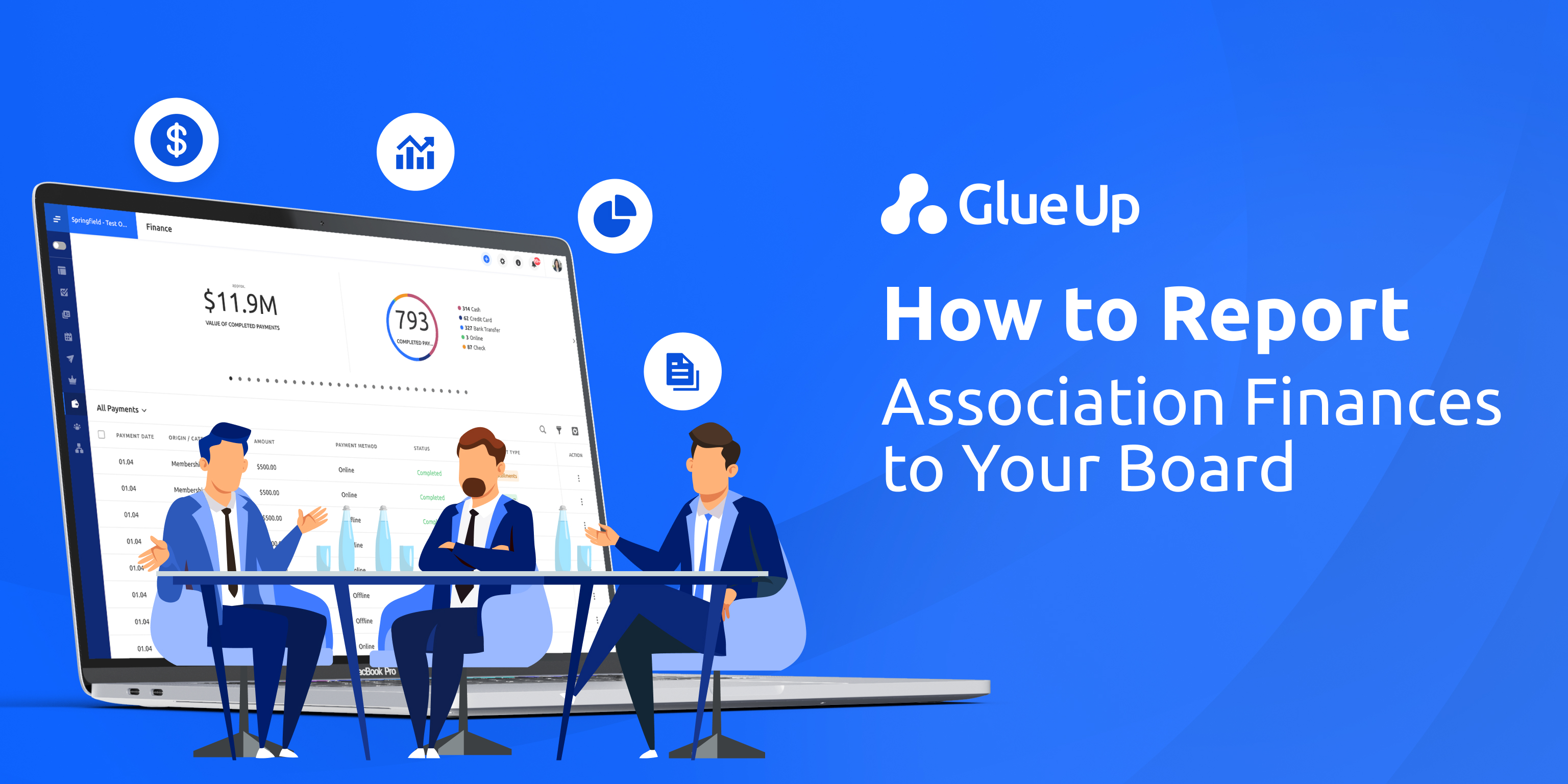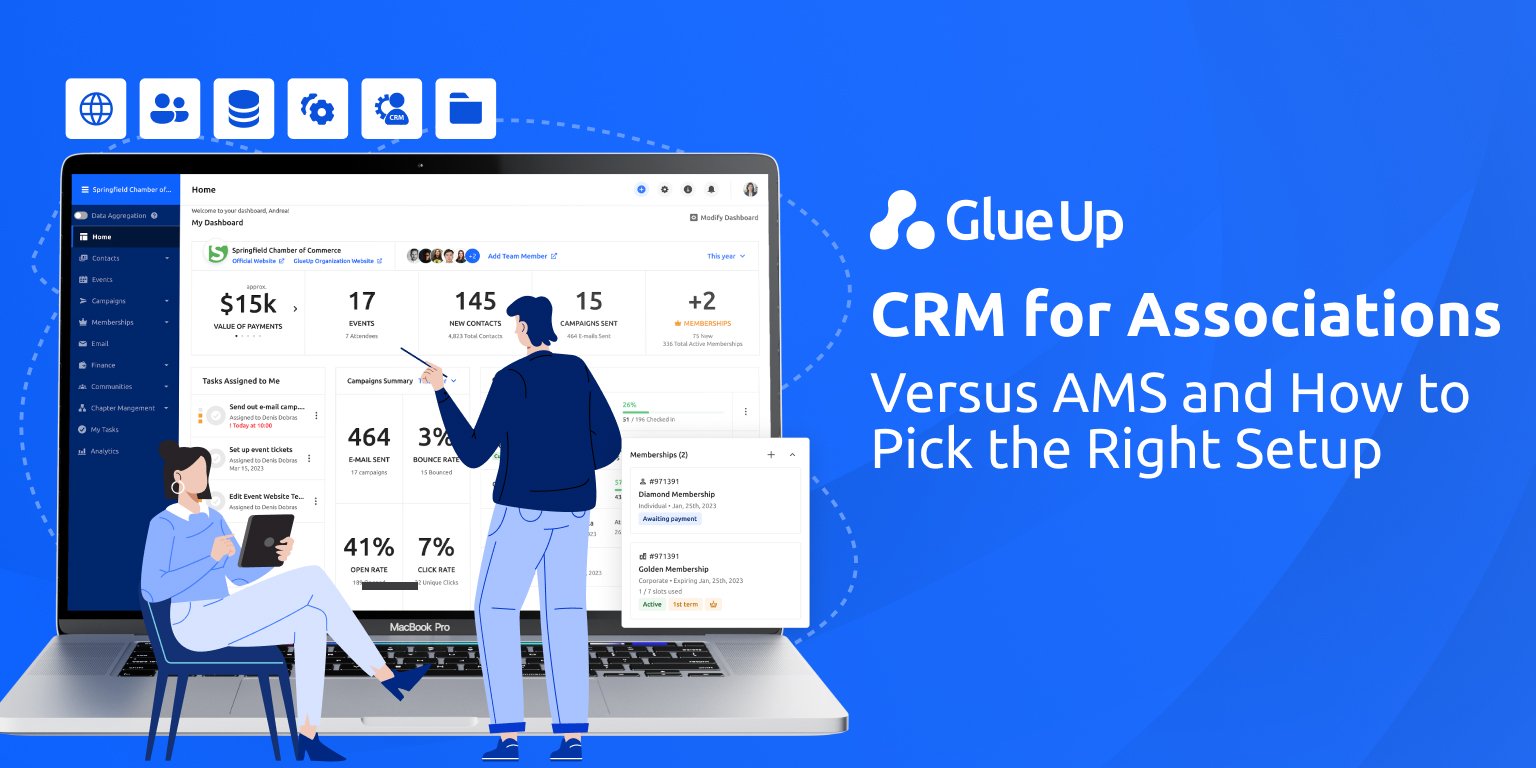
At every board meeting, there’s a quiet moment of truth. The finance packet lands in inboxes, pages fill with numbers, and silence settles as directors try to decode what it all means. Somewhere between “total operating income” and “restricted reserves,” someone always asks the same question: So, are we in the clear or not?
That pause reveals the true purpose of board reporting. It isn’t about producing more data. It’s about translating numbers into confidence, accountability, and clarity.
For associations, board reporting is no longer a formality, it’s a leadership tool. It defines how well the board understands financial performance, how decisions are made, and how trust is built between staff and governance.
This article explores how modern associations can elevate their board reporting practices, from compliance to communication, from spreadsheets to strategy, and how technology like Glue Up’s Finance Suite turns that process into an integrated, repeatable system.
Key Takeaways
Modern associations treat board reporting as strategic storytelling that links data, decisions, and direction. It’s less about presenting numbers and more about translating them into clarity, accountability, and foresight.
Compliance ensures credibility, metrics guide strategic focus, and narrative connects everything into meaning. Together, they give boards both confidence and context to act.
Board packets should be structured the same way each quarter, using visuals, trends, and short explanations. Predictable layouts and visual cues help board members recognize issues quickly and make faster, more informed decisions.
Platforms like Glue Up automate repetitive reporting tasks, integrating membership, events, sponsorship, and finance data into one dashboard. This eliminates manual reconciliation and allows leaders to focus on strategy rather than spreadsheets.
When associations frame financial data around purpose and outcomes, the board stops asking for reconciliations and starts asking for results. Great board reporting builds transparency, strengthens governance, and turns financial oversight into strategic leadership.
Quick Reads
What Board Reporting Really Means
Traditional board reporting was once a static exercise. Finance teams prepared ledgers, balanced budgets, and sent thick packets before meetings. The goal was accuracy.
Today, associations operate in a faster, more transparent environment. Members expect accountability, funders expect data readiness, and boards expect forward-looking insights. Board reporting has evolved from financial documentation into strategic storytelling.
It’s not a record of what happened; it’s a window into why it happened, and what should happen next.
The most effective associations treat board reporting as a continuous feedback loop between operations and oversight. It connects four key elements:
Compliance – Ensuring the board meets fiduciary obligations and audit standards.
Decision metrics – Presenting the financial indicators that drive real choices.
Narrative – Explaining cause, effect, and implications in plain, accessible language.
Technology enablement – Using integrated systems to ensure accuracy and timeliness.
Board reporting is not simply an accounting requirement. It is the narrative spine of association governance.
The Three Layers Every Board Reporting Framework Should Include
1. Compliance: The Foundation of Credibility
Boards hold fiduciary responsibility for an association’s assets. They must ensure compliance with accounting standards, audit expectations, and public-facing disclosures.
Effective board reporting includes:
Net asset breakdowns under FASB 958 (with and without donor restrictions).
Liquidity disclosures, detailing which financial assets are available within 12 months.
Functional vs. natural expense classifications, clarifying both the purpose and type of expenditures.
Audit status and findings, including remediation timelines.
Form 990 review, focusing on transparency and reputational accuracy.
Boards should never have to guess whether a compliance step is complete. Clear reporting eliminates that uncertainty.
2. Decision Metrics: The Signals That Shape Strategy
Beyond compliance, board reporting must help leaders understand performance drivers. The goal is to show trends.
Key metrics that elevate board reporting include:
Liquidity runway – months of operational coverage based on unrestricted cash and receivables.
Operating reserves – target vs. actual, including draw and replenishment plans.
Membership metrics – renewal rate by cohort, new member acquisition cost, and retention trend.
Event and program economics – contribution margin per attendee or program.
Sponsorship health – fulfillment rate, revenue risk, and pipeline confidence.
Variance analysis – deviations from budget with explanations of timing or structural impact.
Risk indicators – top five risks with owners, mitigation steps, and completion status.
Each data point must answer one question: So, what? Board members need insight into what the numbers mean for the mission.
3. Narrative: Turning Data into Decisions
Data without context confuses. Narrative turns it into meaning.
In board reporting, narrative should clearly state:
What changed – concise factual summary.
Why it changed – cause, timing, or external factor.
What’s next – action or decision required.
For example: “Operating revenue increased 12% in Q2 due to higher event participation. However, member renewals dropped 8%, reducing recurring income for Q3. The finance team recommends reallocating event surplus to the membership engagement budget to recover renewal performance.”
This structure keeps the focus on progress and decision-making rather than surprise. It also reinforces transparency, one of the strongest trust signals in association governance.
Structuring Board Reporting That Works
The most effective associations use a repeatable board reporting framework built for consistency and clarity. Below is a proven format used across high-performing organizations.
Front Summary (One Page)
“What changed since last meeting” – three key points.
“What decisions are required” – three clear asks.
Liquidity snapshot – months of runway vs. policy.
Risk status – top three color-coded risks.
Executive Financial Overview (3–4 Pages)
Income, balance sheet, and cash flow with rolling trends.
Liquidity and reserve dashboards with 12-month visuals.
Revenue pillars (dues, events, sponsorships) with variance commentary.
Program and Event Economics (2–3 Pages)
Contribution margin per program.
Attendance, sponsorship, and cost recovery trends.
Scenario views: base, downside, and upside cases.
Risk and Compliance Overview (1–2 Pages)
Top five organizational risks.
Control remediation log.
Audit progress, 990 timeline, and open findings.
Appendices
Audit committee charter.
Glossary of financial terms.
Reserve policy.
Detailed schedules (only if requested).
This structure allows the board to understand financial health in minutes.
The Metrics Boards Actually Use
Not all metrics are created equal. The following measures consistently appear in high-performing board reporting packs:
Months of liquidity available
Operating reserves vs. target
Rolling 90-day forecast accuracy
Membership renewal rate by cohort
Average revenue per member
Event contribution margin per attendee
Sponsorship yield vs. fulfillment rate
Audit findings outstanding
Control remediation time to closure
Variance to budget by revenue source
These metrics, when trended quarterly, help the board see direction. Associations that consistently report them create shared understanding between management and governance.
Common Pitfalls in Board Reporting (And How to Avoid Them)
Even well-run associations make mistakes in how they communicate financials. The most common board reporting pitfalls include:
Information overload – overwhelming packets without a clear summary. Begin with one-page executive insight and move detail to appendices.
Inconsistent visuals – changing layouts and color codes each quarter. Standardize templates for pattern recognition and faster comprehension.
Cash balance without context – showing “total cash” but not available liquidity. Always present cash coverage in months of operation with policy thresholds.
Hidden audit or control issues – lack of transparency on open findings. Include an “audit and remediation log” in every report.
Neglecting the Form 990 review – public-facing information not aligned with board reporting. Make annual 990 review part of the board’s governance calendar.
Technical jargon – alienating directors who are not accountants. Use plain English and define financial terms in a glossary.
Lack of narrative cohesion – no explanation for trends. Frame every table and graph with a one-sentence “so what.”
Good board reporting guides discussion and creates confidence in leadership.
From Overload to Clarity
Consider an association that faced declining liquidity after a slower sponsorship cycle. The board packet had dozens of tables but no context. During the meeting, directors struggled to interpret what mattered most.
The finance team redesigned the board reporting process around narrative and metrics. They introduced a 10-slide report:
Key decisions and performance shifts.
Income statement vs. budget with commentary.
Liquidity trend and policy thresholds.
Reserve position vs. policy.
Membership renewals and acquisition.
Event economics with contribution margins.
Sponsorship health and risk status.
Forecast scenarios.
Audit and compliance overview.
Definitions and appendices.
The new structure transformed the discussion. Instead of debating numbers, the board asked strategic questions: “What’s the plan for sponsorship diversification?” “How can we accelerate membership renewals?”
That shift is what effective board reporting achieves, moving governance from reaction to foresight.
Using Technology to Simplify Board Reporting
Manual board reporting consumes hours every quarter: data exports, reconciliations, formatting, and variance explanations. It’s no surprise that finance teams spend more time preparing numbers than interpreting them.
Modern association technology can change that. Platforms like Glue Up bring automation, accuracy, and clarity to financial storytelling.
How Glue Up Supports Smarter Board Reporting
Unified data source – membership, event, sponsorship, and finance data live in one ecosystem, eliminating manual reconciliation.
Real-time dashboards – financial and engagement metrics update automatically, allowing leadership to build current reports, not static snapshots.
Variance commentary generator – suggests explanations for budget deviations, giving staff a foundation for narrative reporting.
Scenario forecasting – provides base, downside, and upside financial models for each major revenue pillar.
Compliance tracking – tags restricted funds, reserves, and audit items for visibility in every report.
Automated templates – reusable board reporting layouts that refresh quarterly with updated metrics.
By connecting operations to outcomes, Glue Up helps associations present clean, consistent, and credible data to their boards, reducing preparation time and increasing confidence.
FAQs About Board Reporting
What is the ideal target for operating reserves?
Most associations maintain between three and six months of operating reserves. The exact amount depends on revenue volatility, cash flow timing, and mission sensitivity. The critical element is a written policy that defines draw and replenish rules.
How often should board reporting occur?
At least quarterly, with rolling 90-day forecasts recommended for liquidity monitoring. High-impact associations refresh dashboard data monthly to identify risks early.
Do all board members need to review the Form 990?
Not every line, but the board should review and approve the narrative before filing. Public disclosures must align with internal reporting to ensure consistency and transparency.
What if board members lack financial literacy?
Use charts, ratios, and plain language. Visual dashboards and short summaries are more effective than dense financial statements.
What’s the difference between the board packet and the audit committee packet?
The audit committee packet includes deeper control testing and management letter responses, while the board packet focuses on summarized performance and strategic implications.
The Future of Board Reporting
The era of passive board packets is over. Boards no longer need hundreds of lines of figures, they need clarity, credibility, and context.
Modern board reporting tells the story of financial health, risk, and readiness. It connects the dots between what the organization does and how it sustains itself.
Associations that master this balance turn their financial reports into strategic dashboards. They build transparency, improve decision-making, and strengthen relationships with members, funders, and partners.
Glue Up’s Finance Suite empowers that transformation: unifying data, automating reporting, and ensuring that every number supports a clear narrative.
When board reporting becomes storytelling, governance turns into growth.



